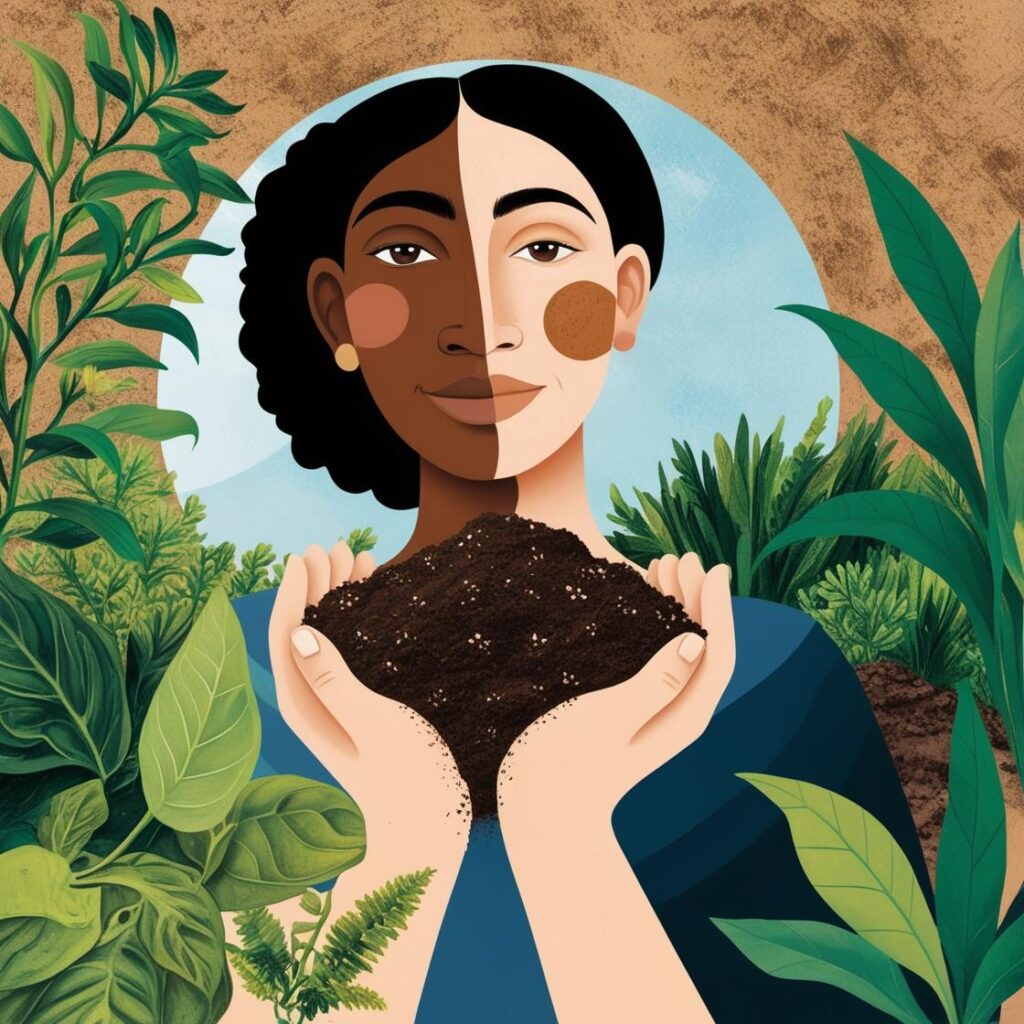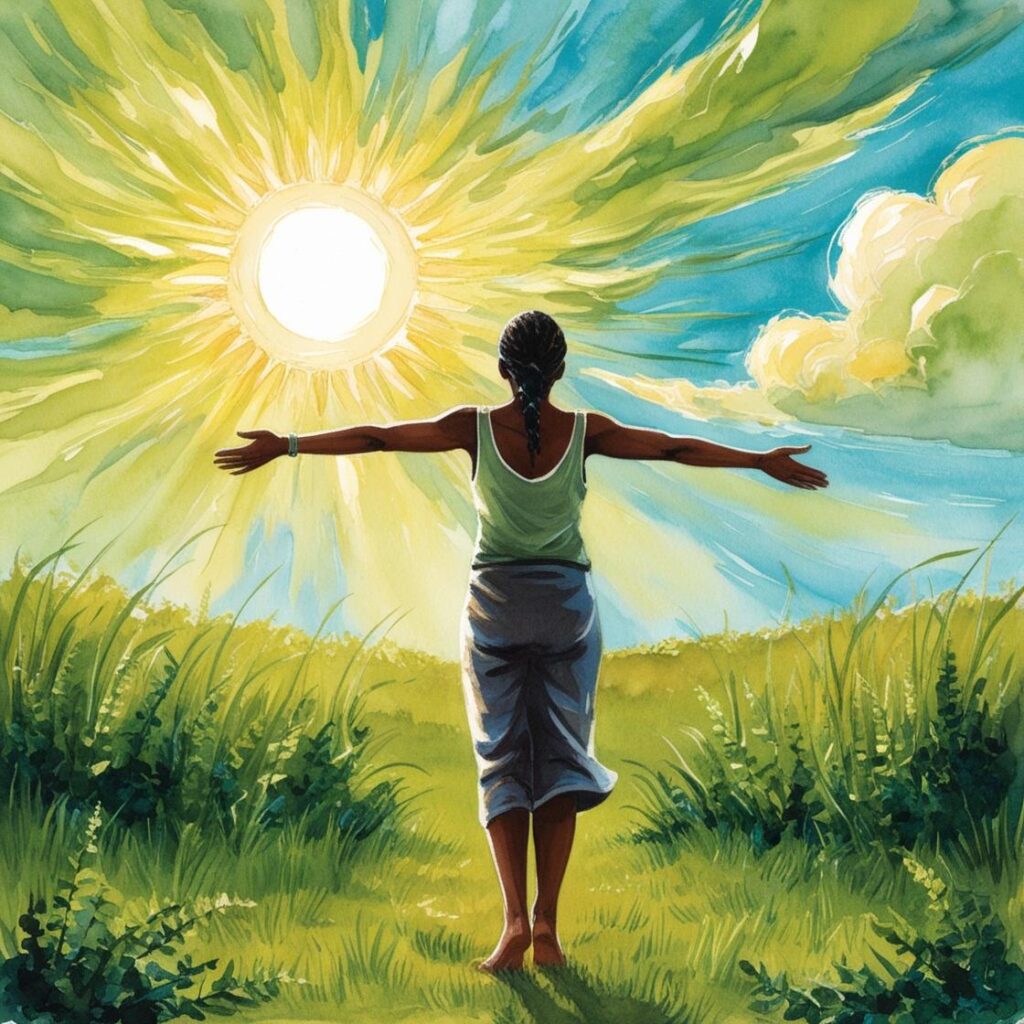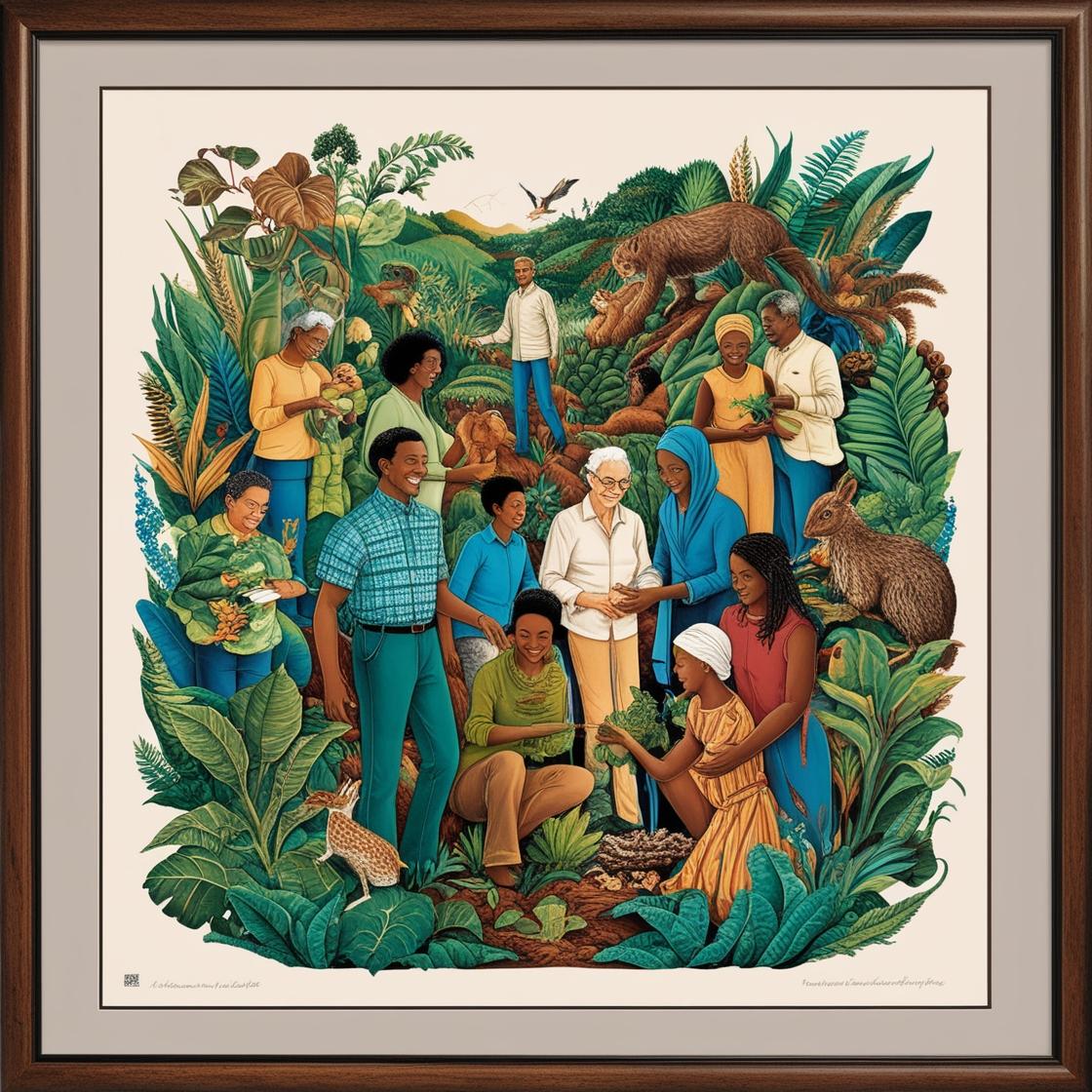In today’s fast-paced world, we often forget our deep-rooted connection to the earth, but it’s important to remember that our bodies and the land are intrinsically linked. How we treat ourselves mirrors how we treat the environment, and both are critical to sustaining life. So, let’s explore the age-old relationship between humans and nature, and how rediscovering this bond can guide us to live better, both physically and environmentally.

1. We Are Part of Creation
Humans are small in the grand scheme of Creation. The natural world has existed for millennia, and our existence is just a tiny part of that grand design. From ancient cave paintings to Chinese landscape art, the message has always been clear: humans belong to nature, not the other way around.
In these early depictions, humans are shown as mere figures in a vast landscape. They emphasize our dependence on nature for survival, rather than dominion over it. Even our bodies are “moving particles of the earth”—we live from the soil, and eventually, we return to it. Whether we acknowledge it or not, agriculture sustains us, and that reliance reflects our fundamental relationship with the land.
Tip: Next time you eat a meal, take a moment to think about where it came from—the earth—and how vital it is to care for the soil that grows our food.
2. The Danger of Overestimating Ourselves
Just as King Lear’s Gloucester stands on the edge of a cliff in despair, believing he can no longer control his fate, we often find ourselves at the edge when we lose sight of our place in the world. Shakespeare’s play emphasizes how easily pride can lead to blindness. Gloucester’s emotional and physical blindness represents our own lack of vision when we think we can dominate nature.
The lesson here is that understanding our limits within Creation can save us from self-destruction, both individually and as a society. Humans cannot be gods, nor should we strive to control what we didn’t create.
Actionable Insight: Reflect on the natural processes you can’t control—the changing seasons, the growth of plants, or the cycle of life. Instead of trying to dominate them, work with them in your daily life.
3. Rediscovering Humility in Nature
In ancient times, when people wandered into the wilderness, they learned their place in the universe, often returning with renewed understanding and respect for nature. Today, our modern conveniences have made it easy to forget this. We travel to scenic views for leisure, but we’ve lost touch with the true wilderness.
Back then, people didn’t measure a mountain by its height but by the awe it inspired. Now, we’re obsessed with stats—how many states we can see from the top or how far we’ve come. Our accomplishments with technology and construction have made us feel larger than life, but at the same time, they’ve shrunk us, reducing our importance in the grand scheme of things.
Tip: Next time you’re in nature, focus less on capturing the perfect photo and more on feeling your place within the environment. Let the vastness of the landscape remind you of your connection to something bigger.
4. Balancing Power and Destruction
As our technological advancements continue to grow, so does our impact on the planet. Our machines make us feel powerful, but they also remove us from the natural scale of life. We’ve built towering cities and massive machines, but these creations often make us feel insignificant.
The more we try to control nature, the further we distance ourselves from it. And while progress is necessary, it’s critical to remember that without the earth, none of these advancements would be possible. If we forget that, we risk falling into the same despair as Gloucester.
Actionable Insight: Consider how you interact with technology in your everyday life. Are there ways to scale back and reconnect with nature? Simple steps like growing a garden or walking in a park can help bridge the gap.
Conclusion: Key Takeaways for Instagram Reels & Infographics
- Connection to Creation: We are not separate from the earth; we come from it, and we return to it.
- Humility Over Pride: Recognizing our small place in the grand design of nature can lead to balance and better decisions.
- Natural Limits: We can’t and shouldn’t try to control nature. Understanding our role within it is key.
- Technology and Nature: While technology can enhance life, it also distances us from nature. Find ways to reconnect.
- Actionable Steps: Practice mindfulness in your daily interactions with nature, from where your food comes from to how you engage with the environment.
Use these insights for visual content like Instagram Reels or infographics on platforms like Canva, focusing on the timeless relationship between humans and the earth.
The passage presents a critical analysis of the sexual division and its impacts on the relationships between men and women, particularly within the context of industrial and modern societies. It discusses how the division of body and soul creates further societal divisions, most notably sexual and ecological, and how these divisions distort fundamental relationships between individuals and their environment.

Key points include:
- Division of Body and Soul: The separation of body and soul leads to a devaluation of the body, reducing it to an object. This mindset extends to societal roles, where tasks related to nurturing are undervalued and deemed the domain of women.
- Sexual Division and Nurture: In industrial societies, men become disconnected from nurturing, which is increasingly relegated to women. This process not only confines women to specific domestic roles but also diminishes the perceived importance of their work. Women’s roles in nurturing become trivialized, and they are reduced to consumers in a cash economy, leading to their exploitation by market forces.
- Isolation of Women: Women are isolated in their roles as housewives, which are simplified and stripped of dignity. Their connection to their husbands and the larger community is weakened as they are encouraged to focus on appearances and consumerism rather than on the substance of their work or relationships.
- Sexual Division in Marriage: In modern marriages, the division of work leads to the dissolution of the household as a meaningful bond between husband and wife. This division isolates sexual energy from its traditional roles in the household and community, reducing sexuality to a source of tension rather than a source of unity and creation.
- Capitalization of Sexuality: The romanticization of love and marriage in popular culture sets unrealistic expectations for couples, leading to disappointment and frustration. As a result, sexual relationships become transactional, and marriage turns into a competitive market where couples view each other as property.
- Impact on Community: The isolation of sexual energy and the commodification of marriage contribute to the disintegration of the community. The shift from communal activities, like group dances, to isolated, individual experiences reflects this broader social fragmentation.
In conclusion, the text critiques how industrialization and capitalism have transformed gender roles and sexual relationships, leading to a profound alienation between men and women, as well as a weakening of communal and ecological bonds. This sexual division not only harms individual relationships but also damages the broader social fabric.
The passage you’re referring to is from Wendell Berry’s The Unsettling of America. Berry reflects on the disintegration of marriage and community, drawing an analogy between the decline of marriage and the degradation of the land and environment. He critiques how modern society has encapsulated sexuality and marriage, turning them into systems of competition and ownership, much like how industrial capitalism exploits land and resources.
Berry argues that by confining sexuality to a narrow, possessive framework, marriage becomes a “sexual cul-de-sac,” wherein the couple is fenced in, estranged from both the vitality of sexuality and the broader community. He likens this to economic competition, where the exclusive pursuit of property leads to a deadening of the human spirit, resulting in the “household of the living dead.”
The core of his argument is that fidelity, which has often been reduced to a grim duty enforced by willpower, should instead be understood as a virtue with purpose—a necessary discipline that brings harmony between individuals and the community. Fidelity isn’t just a personal or spiritual duty; it connects individuals to the larger social and ecological fabric. Berry suggests that marriage, like the responsible use of energy, requires balance and respect for its power.
Drawing on The Odyssey, Berry explores how the journey of Odysseus to return home to Penelope reflects a deeper moral and geographical order, where fidelity is tied not only to his wife but also to his homeland, symbolizing a more profound sense of belonging and responsibility to the earth and community.
In sum, Berry emphasizes that true fidelity—whether in marriage, community, or land stewardship—requires a recognition of the broader connections between individuals, society, and the natural world. Only by living responsibly within these connections can we achieve wholeness, rather than being trapped in the isolated and competitive frameworks that modern society has imposed on both human relationships and the environment.
This passage presents a profound meditation on the interconnection between human culture, agriculture, marriage, and fertility, exploring how these fundamental aspects of life are intricately tied to natural processes and moral responsibility. The author uses The Odyssey to highlight the cultural and symbolic significance of marriage, which is not merely a legal or sacred bond but an essential part of a broader system that encompasses family, community, tradition, and the land. Odysseus’ journey, with its ultimate return to home, represents a deep fidelity to this natural order—one that cannot be reduced to a simple contract of sexual exclusivity. The Odyssey, in this reading, presents an “anti-Iliad,” emphasizing domestic values over the warrior ethos of conquest and violence, while also showing that these two worlds, domesticity and adventure, cannot exist in opposition but are deeply interconnected.
In this broader framework, marriage is seen as a crucial link between the human community and the earth, drawing parallels to agriculture. The homecoming of Odysseus is a return not just to his wife, Penélopê, but to the land, to the fields, and ultimately to a life that respects the natural cycles and rhythms of the earth. His final task—planting an oar in the ground as an act of atonement—symbolizes the transformation of a tool of war into one of agriculture, signifying a shift from destructive force to nurturing and creation. This gesture echoes the Biblical prophecy of turning “swords into plowshares,” reflecting a movement away from violence and exploitation toward peace and cultivation.
The author argues that contemporary culture has failed to maintain this crucial connection between sexuality and fertility, between human relationships and the earth. Modernity has divided sexuality from fertility through technological means—contraceptives, sterilization, and artificial fertility treatments—leading to a loss of moral and cultural responsibility. Just as industrial agriculture has separated humans from the fertility of the land, technological birth control has removed sex from its natural, fertile context, reducing it to a matter of pleasure without consequence. This disconnect is presented as both a cultural and ecological crisis, a “short-circuit” of the natural order that leads to exploitation and degradation of both human bodies and the earth.
The text calls for a renewal of cultural practices that integrate sexuality with fertility and agriculture with the natural environment. This involves not only respecting natural limits and processes but also understanding that fidelity to human relationships (such as marriage) requires a corresponding fidelity to the earth and its cycles. Restraint, discipline, and the acknowledgment of natural forces are necessary for both human and ecological health.
Ultimately, the passage suggests that a culture that hopes to endure must embrace a “double faith”—one that honors both the wildness of nature and the order of human society. This includes recognizing the necessity of natural wilderness within the human world and allowing for spaces of renewal and mystery, both in nature and in human relationships. Without such an integration, the author warns, modern society risks continuing to exploit the earth and human connections for short-term gain, losing the deeper, more sustaining relationships that ground culture, community, and life itself.
This passage reflects on the disconnection between modern industrialized agriculture and the natural cycle of fertility. The author, Wendell Berry, criticizes the reduction of the body to a mere consumer of food and its exclusion from the larger process of life, where nutrients are not returned to the soil but instead become waste. This separation leads to a system that turns the body’s fertility into pollution, benefiting agribusiness while impoverishing the earth.
Berry traces this problem to a deep-rooted division between the body and the soul, suggesting that modern technology, like flush toilets and sewage systems, removes human waste from the ecological cycle. Instead of recognizing these wastes as valuable and necessary for replenishing the soil, society views them as offensive, leading to pollution and the depletion of natural resources. This, Berry argues, is an extension of the urban-rural divide, where urban centers consume the energy and resources of the countryside without returning any of it, leading to disintegration and decay in both rural and urban areas.
At the heart of Berry’s critique is the idea that health and well-being come from maintaining connections—between the body and the earth, food production and consumption, work and life. He contrasts the modern industrial economy, which thrives on fragmentation and conflict, with a vision of holistic work, where growing food is not drudgery but a sacramental act that connects individuals to the natural world. This kind of work, Berry argues, restores dignity, conviviality, and a sense of responsibility, showing that the health of both people and the land depends on understanding and enacting these connections.

About Us
Welcome to Agriculture Novel, your go-to source for in-depth information and insights into the world of agriculture, hydroponics, and sustainable farming. Our mission is to educate, inspire, and empower a new generation of farmers, hobbyists, and eco-conscious enthusiasts. Whether you’re interested in traditional farming practices or modern innovations, we aim to provide comprehensive guides, expert tips, and the latest updates in agriculture and urban farming.
At Agriculture Novel, we believe in the power of knowledge to transform the way we grow, sustain, and nourish our world. Explore our articles on topics like Fruit Growing Guide, Hydroponics, Plant Deficiency Guide, and more.
Thank you for joining us on this journey towards a greener, more sustainable future!
About Agronique Horizon
At Agronique Horizon, we specialize in delivering comprehensive digital marketing and web development solutions tailored for the agriculture and hydroponics industries. From custom website design and app development to social media management, we provide end-to-end support for brands aiming to make a meaningful impact. Our team also offers innovative solutions for the real estate sector, bringing precision and visibility to your projects. Learn more about our services here and discover how we can elevate your digital presence.


